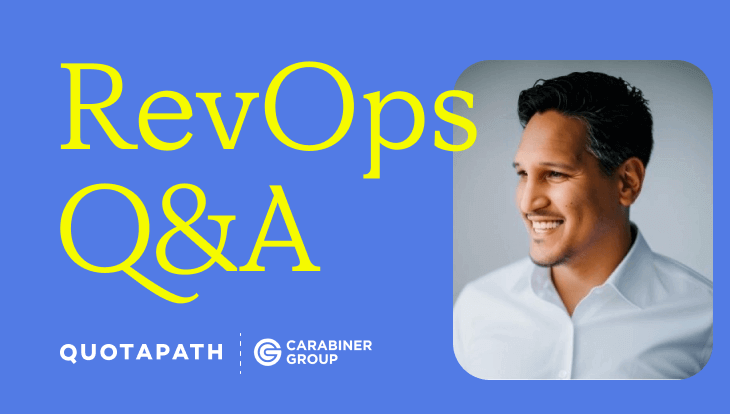This guest post on becoming a strategic revops leader was written from our friend James Geyer, Co-founder of AccountAim.
Revenue Operations (RevOps) is one of the fastest-growing functions in B2B.
As companies seek more cross-functional alignment, consistent growth, and better customer experiences, RevOps is moving from a back-office support role to a top-line driver of business performance.
But not everyone fully understands RevOps yet. Many organizations still treat RevOps as a reactive function: a Salesforce admin, a report builder, a catch-all for GTM drudgery. And for many RevOps professionals, that limited perception makes it hard to grow. Even senior operators struggle to earn a seat at the leadership table, let alone shape strategy.
That’s what makes Katherine Zhang’s story so compelling.
Katherine spent her early career in strategy consulting before transitioning into sales and RevOps leadership roles at enterprise-scale companies, including EMC and Dell. She went on to become SVP of RevOps at Project44, where she built the function from the ground up, and now serves as CEO of OPEXEngine — proving just how far RevOps leaders can go when they’re positioned as strategic partners, not taskmasters.
Below, Katherine shares what it takes to build credibility, influence the go-to-market strategy, and evolve from an order-taker to an executive leader.

Meet Katherine Zhang
Katherine Zhang is the CEO & GM of OPEXEngine by Bain & Company, the leading performance benchmarking solution for SaaS and software companies. Previously, she spent over a decade building and leading growth strategy and revenue operations teams to scale tech companies including Project44 and Relativity.
How to become a strategic RevOps leader: Q&A
First, how do you define RevOps?
I see RevOps as the alignment and coordination of go-to-market resources to enable the ideal customer journey. That means aligning on strategy (who we’re targeting and what experience we want to create), coordinating the right processes to deliver on that strategy, and executing in a way that consistently supports the customer throughout their journey.
And, what attracted you to RevOps and what keeps you in it?
I love building teams and solving complex problems. In RevOps, there’s always something new to fix whether it’s improving the forecast, refining handoffs, or rolling out new tools. I also enjoy the variety. In one day, I might go from reviewing the pipeline with marketing, to discussing compensation with finance, to meeting with IT about systems changes. That breadth keeps things interesting.
What’s the difference between reactive and strategic RevOps?
At the start, RevOps has to be reactive. There’s foundational work that just has to get done. But if you stay in that mode, you become an implementer, not a decision-maker. The shift to strategic happens when RevOps starts bringing ideas forward. Instead of waiting for someone to ask for a report, you’re saying, “Here’s a new insight and what I think we should do about it.” That’s when you earn trust and influence.
“Strategic RevOps means understanding not just what the data says, but what it means for the business.”
What does it take to become a trusted strategic partner?
Start by nailing the basics. You need a function that runs well and consistently. But trust doesn’t come from perfection. It comes from being transparent about what your data shows and what its limitations are. You don’t need perfect data to be credible. You need to understand the data deeply, explain where it might be incomplete, and still offer a confident recommendation.
How do you communicate the value of RevOps to leadership?
RevOps becomes the hub of commercial operations. The place people go to understand how go-to-market is functioning. Especially in larger orgs, where no one has full visibility, RevOps becomes the connective tissue. Yes, you’re building systems. But you’re building systems that translate strategy into coordinated execution and align the business around it.
For someone earlier in their RevOps career, how can they grow into a more strategic leader?
Two pieces of advice. First, know your strengths and the blind spots that come with them. I’m great at simplifying complex problems, but I know that can make me prone to missing details. So I make sure to bring subject matter experts into the conversation to close that gap. Second, observe the leaders around you. What behaviors earn respect? How do they influence a room? That kind of organizational awareness is just as important as technical skills.
About AccountAim
AccountAim is the planning and analytics platform built for Strategic RevOps teams. With AccountAim, RevOps teams connect all of their fragmented GTM data, automatically snapshot and see trended changes over time, and build full-funnel reporting — all without SQL or data team support.
Learn how Strategic RevOps teams use AccountAim to streamline forecasting, territories, cross-sells and more here.
What challenges emerge when building RevOps at scale?
At scale, you can’t rely on tribal knowledge anymore. Every exception starts to create ripple effects across the system. So you need to define clear processes and stick to them. That requires more than policy. It requires communication. I’ve seen huge success just by explaining why a new rule or change exists. When people understand the impact, they’re much more likely to adopt it.
What do you see as the biggest opportunity in RevOps tech today?
Two areas stand out. First is data. We’ve spent years building tools to collect and report on data. However, we now need tools that help us interpret it, spend less time extracting data, and more time acting on insights. Second is enablement. We need to meet the field where they are. Spreadsheets and email aren’t going to cut it. We need tech that embeds into their daily workflows, whether that’s Slack, CRM, or somewhere else.
Lastly, how do you approach getting up to speed on data in a new org?
Be curious. Whether you’re a junior team member or a senior leader, start by listening. Ask how processes came to be. Sit with subject matter experts. Don’t just learn what’s happening, learn why. That context will help you spot gaps and opportunities others might miss. Take a page out of the sales rep playbook and embrace discovery as a foundational RevOps skill.
********************
Thanks for the thoughtful Q&A, James and Katherine!
Design, track, and manage variable incentives with QuotaPath. Give your RevOps, finance, and sales teams transparency into sales compensation.
Talk to SalesWant to be more strategic in your RevOps role? Start using your compensation plans to drive key selling behaviors that result in the best kinds of customers for your business. Provide your teams with visibility and alignment while automating commission tracking and payments.
To see how you can leverage QuotaPath to be more influential with your RevOps jobs-to-be-done, schedule time with our team here.



